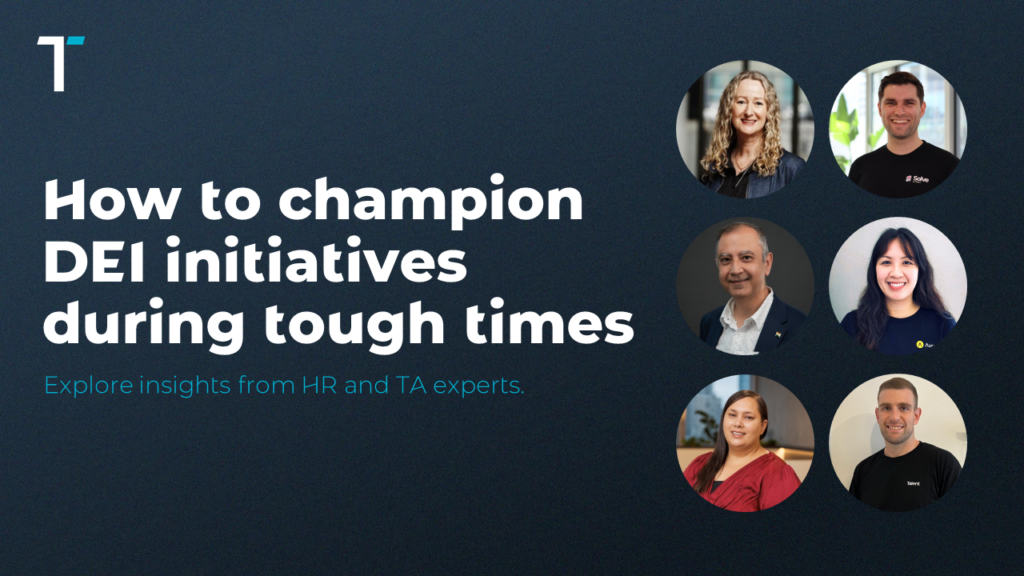
DEI in Danger: How to champion DEI initiatives during tough times
DEI in Danger: How to champion DEI initiatives during tough times

In today’s tough economic climate, many New Zealand businesses are facing hard choices about where to invest. Despite the downturn experienced in the last 12-18 months, our clients are telling us that Diversity, Equity and Inclusion (DEI) remains a critical priority but is often at risk of being sidelined by budget pressures and competing concerns.
Kara Smith, Managing Director of New Zealand, and Tom Bailey, Senior Consultant here at Talent speak with leading HR and TA experts who share their practical tips, and insights on overcoming barriers, as well as how to make a strong case for DEI investment during uncertain times.
Know your ‘why’: Approaching DEI with clear intentions
Katrina Hau, Director of People Experience at Auror, emphasises the importance of intentionality and the need for a strategic approach to DEI. While DEI ultimately isn’t about hitting targets, it’s important to have an idea or goal in mind for specific areas, for example in engineering, where women are underrepresented. She states her three key steps are to “find a baseline, identify the teams or areas you really want to be intentional about”, and then, for Auror, it was to look at their leadership. “We really wanted our C-suite of six people to be fifty-fifty, and to this day it’s fifty-fifty,” she notes, illustrating the trickle-down effect of diverse leadership into the makeup of the company which similarly reflect this gender balance.
Understanding privilege and unpacking unconscious bias
Sid Kumar, a technologist and people leader as a Head of Product, actually challenges the traditional order of DEI, suggesting that ‘Equity’ should be addressed first. “You must think of equity first, everyone is not equal, and some people simply need help levelling the playing field,” Sid states, highlighting the importance of understanding equity as a precursor to true diversity and inclusion.
He also addresses the complexities of hiring for merit and the need for ongoing conversations about unconscious biases. “I have a large team of 250 people in my department and there’s a belief that people must be hired on merit, but how do you define that? In the first 5 minutes of the interview, can you truly see that merit? For technical roles, you can ask problem-solving questions but for leadership roles, it’s an ongoing conversation.”
He also adds, having hiring managers confront their unconscious bias “makes people uncomfortable, and you can’t change that in just 2 hours of DEI training – it’s impossible!” and is advocating for a deeper commitment to change. Sid states that leaders must identify their “why” to avoid tokenism, while Cameron Robinson, Head of Enterprise Solutions at Solve, aptly reminds us that talent acquisition leaders don’t need permission to implement what should simply be good hiring practices instead of so-called “DEI hiring”.
DEI on a budget: Creative solutions
In the absence of funding during uncertain times, what are creative no or low budget strategies HR leaders can implement now?
Katrina suggests leveraging DEI surveys to understand gaps and engage employees and the tangible benefits of one of Auror’s DEI initiatives, transparency in salary bands, which fostered equity and inclusion. “It wasn’t quick, but it’s best to start now before the organisation gets bigger and it gets more complex,” she advises.
Sarah Bellett, Head of People Experience at One NZ, shares how their rebranding process became a catalyst for DEI-focused change and, like Katrina, uses surveys to get to know their people and address their needs. “We surveyed our people and found that 50% are caregivers of some kind so we worked with them to redefine our policies to be meaningful,” Sarah said. This also helped reveal the ‘cultural tax’ that employees of marginalised groups have experienced and led to the business supporting them with employee-led networks through kai (food) and time. It was an effective and strategic shift to help make their organisation a great place to work.
Sarah also points out the power of data in communicating the value of DEI to leadership. “Boards and executives like numbers, talking vaguely about DEI might have their eyes glaze over, but putting numbers in front of them are far more compelling.”
From a hiring perspective, Cameron spoke to the power of persona-based hiring strategies and being intentional about which platforms to advertise jobs. He further explains, “Being very targeted about the imagery and language used to find candidates” is key to attracting the talent you seek and comes at no extra cost.
He adds, “Think about how you’re writing your job ads; really practical things like words – ‘competitive’, ‘challenge’, ‘courageous’ are considered masculine words and may deter female candidates from applying for your jobs,” suggesting running job ads through free gender decoder tools that can flag gendered language.
Sid urges leaders to think long-term, “The change that you make is not just for you, it’s for generations ahead.” DEI can be a cornerstone of an organisation’s identity and success, through intentional actions and leadership commitment as demonstrated by our panellists. Even when budgets are tight, DEI can continue to flourish and become a strategic advantage that can help businesses thrive during economic downturns.
If you would like to learn more about implementing better hiring practices, head to our DEI Hiring Toolkit: Less Talk, More Action. To continue this conversation and discuss how Talent can help you create a diverse and inclusive workplace, contact us here.